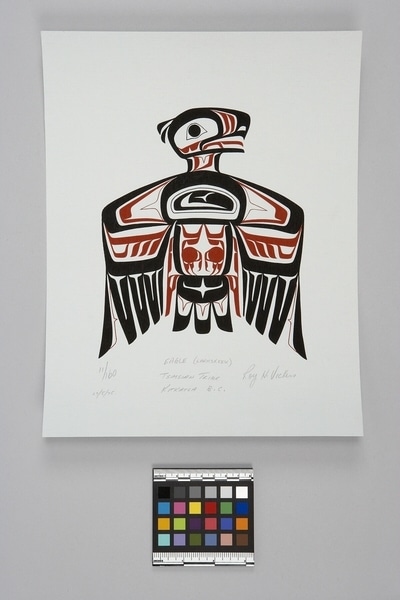Print Item Number: Nb7.225 from the MOA: University of British Columbia

Description
Silkscreen print design of an eagle (larhskeek). The head is in profile and facing to the right side. Has a circular black eye outlined by a tapering oval. The black beak has two sideways red u forms and a blank upside down u form. The open black mouth has a red tongue. There are two red u forms behind the mouth. Two small feather-like shapes are down along the top of the head. The neck has a red split u. The chest has a black ovoid with an L-shape and a t-shape. At either side, there is a sidewsays red split u surrounded by a black u form. Belwo this, there is a red u form above a smaller one and three red s-shapes, all of which are surrounded by a larger black u form. Below this, there are five black feathers. The red claws are inward on the body. The tail has has three feathers, each of which has a red split u surrounded by a larger black u form. Pencil inscription across the bottom edge reads '11/160 29/05/75 EAGLE (LARHSKEEK) TSIMSIAN TRIBE KITKATLA B.C. Roy H. Vickers'. The print is on a vertically rectangular, light grey-blue paper piece.
History Of Use
Silk-screen prints are a major form of contemporary Indian art. Silk-screen printing emerged in the 1950's as a new non-traditional art form, and was easily adapted to traditional Northwest Coast 2 dimensional design concepts.
Cultural Context
contemporary art
Item History
- Made by Roy Henry Vickers (Maker) in British Columbia, Canada on May 29, 1975
- Owned by Roy Henry Vickers before September 26, 1975
- Received from Unknown (Funding source) and Roy Henry Vickers (Seller) on September 26, 1975
What
- Name
- Identification Number
- Nb7.225
- Type of Item
- Manufacturing Technique
- silkscreened
- Overall
- height 33.0 cm, width 25.6 cm, depth 0.1 cm
Who
- Culture
- Tsimshian
- Creator
- Roy Henry Vickers (Maker)
- Previous Owner
- Roy Henry Vickers
- Received from
- Unknown (Funding source) and Roy Henry Vickers (Seller)
Where
- Holding Institution
- MOA: University of British Columbia
- Made in
- British Columbia, Canada
When
- Creation Date
- on May 29, 1975
- Ownership Date
- before September 26, 1975
- Acquisition Date
- on September 26, 1975
Other
- Item Classes
- works on paper
- Condition
- good
- Accession Number
- 0289/0001